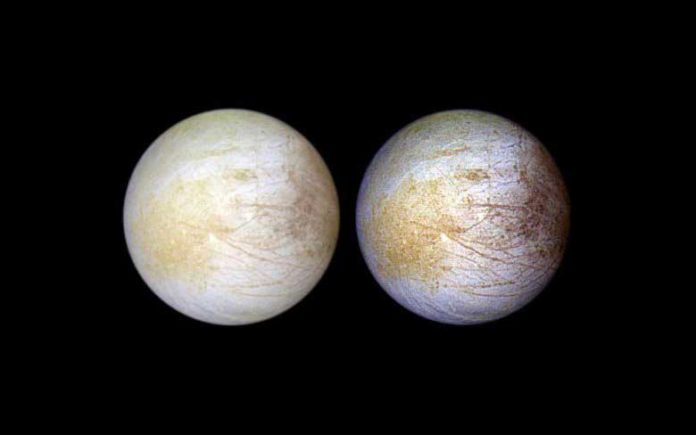Slightly smaller than Earth’s Moon, Jupiter’s moon Europa is primarily made of silicate rock and has a water-ice crust and probably an iron-nickel core. It has a very thin atmosphere composed primarily of oxygen. Beneath its icy crust, Europa hosts a salty, liquid-water ocean in contact with a rocky seafloor, making it an exciting place to explore habitability in the solar system.
However, the ocean’s potential to support life relies heavily on its composition and chemical energy budget, which remain largely unconstrained.
The best window to understanding Europa’s ocean chemistry is to study the composition of its geologically young and active surface.
Investigations using Galileo Near-Infrared Mapping Spectrometer data led to the prevailing view that Europa’s endogenous units are rich in sulfate salts. However, using a visible light spectral analysis, planetary scientists at Caltech and the Jet Propulsion Laboratory, which Caltech manages for NASA, have discovered that the yellow color visible on portions of the surface of Europa is actually sodium chloride, a compound known on Earth as table salt, which is also the principal component of sea salt.
The discovery, in other words, suggests that the salty subsurface ocean of Europa may chemically resemble Earth’s oceans more than previously thought.
The prevailing interpretation of spectra from the Galileo Near-Infrared Mapping Spectrometer (NIMS) suggests a surface dominated by three chemical terrains: water ice, sulfuric acid hydrate, and additional non-ice material, which, since the time of the Galileo mission, has been interpreted as endogenous sulfate salts from the interior ocean.
Galileo’s spectrometer found water ice and a substance that appeared to be magnesium sulfate salts—like Epsom salts, which are used in soaking baths. Since the icy shell is geologically young and features abundant evidence of past geologic activity, it was suspected that whatever salts exist on the surface may derive from the ocean below. As such, scientists have long suspected an ocean composition rich in sulfate salts.
That all changed when new, higher spectral resolution data from the W. M. Keck Observatory on Maunakea suggested that the scientists weren’t actually seeing magnesium sulfates on Europa. Most of the sulfate salts considered previously actually possess distinct absorptions that should have been visible in the higher-quality Keck data. However, the spectra of regions expected to reflect the internal composition lacked any of the characteristic sulfate absorptions.
Mike Brown, the Richard and Barbara Rosenberg Professor of Planetary Astronomy at Caltech said, “We thought that we might be seeing sodium chlorides, but they are essentially featureless in an infrared spectrum.”
However, Kevin Hand at JPL had irradiated ocean salts in a laboratory under Europa-like conditions and found that several new and distinct features arise after irradiation, but in the visible portion of the spectrum. He found that the salts changed colors to the point that they could be identified with an analysis of the visible spectrum. Sodium chloride, for example, turned a shade of yellow similar to that visible in a geologically young area of Europa known as Tara Regio.
Hand, a scientist at JPL said, “Sodium chloride is a bit like invisible ink on Europa’s surface. Before irradiation, you can’t tell it’s there, but after irradiation, the color jumps right out at you.”
Caltech graduate student Samantha Trumbo said, “No one has taken visible wavelength spectra of Europa before that had this sort of spatial and spectral resolution. The Galileo spacecraft didn’t have a visible spectrometer. It just had a near-infrared spectrometer.”
Using Hubble Space Telescope, scientists identified a distinct absorption in the visible spectrum at 450 nanometers, which matched the irradiated salt precisely, confirming that the yellow color of Tara Regio reflected the presence of irradiated sodium chloride on the surface.
Brown said, “We’ve had the capacity to do this analysis with the Hubble Space Telescope for the past 20 years. It’s just that nobody thought to look.”
While the finding does not guarantee that this sodium chloride is derived from the subsurface ocean (this could, in fact, simply be evidence of different types of materials stratified in the moon’s icy shell), the study’s authors propose that it warrants a reevaluation of the geochemistry of Europa.
Trumbo said, “Magnesium sulfate would simply have leached into the ocean from rocks on the ocean floor, but sodium chloride may indicate that the ocean floor is hydrothermally active. That would mean Europa is a more geologically interesting planetary body than previously believed.”
The finding was published in Science Advances on June 12.
